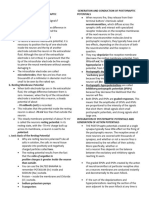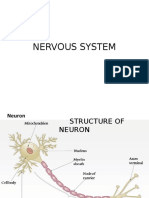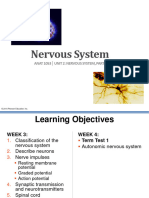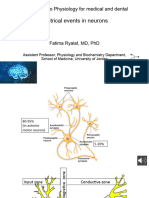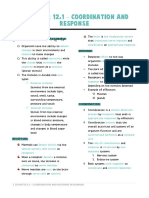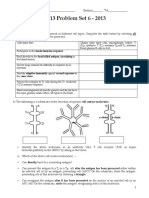0 ratings0% found this document useful (0 votes)
41 viewsBiopsych 02/07/2015: 1. Resting Membrane Potential
The document discusses the resting membrane potential of neurons and the factors that contribute to it. The resting potential results from an unequal distribution of ions across the neuronal membrane, maintained by selective permeability of the membrane to different ions as well as sodium-potassium pumps that actively transport ions against their gradients. When neurons fire, they release neurotransmitters that can depolarize or hyperpolarize the receiving neuron, generating excitatory or inhibitory postsynaptic potentials. The summation of these graded potentials over space and time can lead the receiving neuron to reach its threshold potential and fire an all-or-none action potential to transmit a signal.
Uploaded by
Marvic SueltoCopyright
© © All Rights Reserved
Available Formats
Download as DOCX, PDF, TXT or read online on Scribd
0 ratings0% found this document useful (0 votes)
41 viewsBiopsych 02/07/2015: 1. Resting Membrane Potential
The document discusses the resting membrane potential of neurons and the factors that contribute to it. The resting potential results from an unequal distribution of ions across the neuronal membrane, maintained by selective permeability of the membrane to different ions as well as sodium-potassium pumps that actively transport ions against their gradients. When neurons fire, they release neurotransmitters that can depolarize or hyperpolarize the receiving neuron, generating excitatory or inhibitory postsynaptic potentials. The summation of these graded potentials over space and time can lead the receiving neuron to reach its threshold potential and fire an all-or-none action potential to transmit a signal.
Uploaded by
Marvic SueltoCopyright
© © All Rights Reserved
Available Formats
Download as DOCX, PDF, TXT or read online on Scribd
You are on page 1/ 2
BIOPSYCH
02/07/2015
1. Resting Membrane Potential:
When the electrode tips are put both in the extracellular
membrane, the difference of the voltage is between zero. But,
when one tip is inserted to a neuron and the other on the
extracellular membrane, the potential inside the neuron is 70mV
less than the outside of the neuron. This is called the neurons
resting potential. Negatively and positively charged particles are
called ions. Resting potential results from the fact that the ratio
of negative to positive charges is greater inside the neuron than
the outside.
There are four kinds of ions that contribute significantly to the
resting potential: sodium ions (Na+), potassium ions (K+), chloride
ions(Cl-), and various negatively charged protein ions.
There are four factors that mainly contribute to the unequal distribution of
charges:
The first two of the four acts to distribute ions equally through out the
intracellular and the extracellular fluids.
1. Random Motion- ions that are in random motion tend to
become evenly distributed because they are more likely to move
from areas of high concentration to areas of low concentration
than vice versa.
2. Electrostatic Pressure any build-up of charges, whether
positive or negative, tends to be dispersed by repulsion among
the like charges in the vicinity and the attraction of opposite
charges concentrated elsewhere.
The second two factors of the four are responsible for the unequal
distiribution of Na+,K+,Cl3. Passive- does not involve the consumption of energy
4. Active- involves the consumption of energy
*In resting ions, K and Cl ions pass readily through the neural
membrane, Na ions pass through it with difficulty and negatively charged
protein ions do not pass through it at all
Ion channels are specialized pores where ions pass through the
neural membrane
Sodium-Potassium Pumps are ion transports performed by energy
consuming machanisms in the cell membrane. It continually exchanges
three Na+ ions inside the neuron for two K+ ions outside.
More transporters, which are mechanisms in the membrane of a cell
that actively transport ions or molecules across the membranes, have
been discovered since the discovery of the sodium-potassium pumps.
2. Generation and Conduction of Postsynaptic Potentials
Whenever neurons fire, they release from neurotransmitters
from their terminal buttons. Usually, they bind to postsynaptic
receptors and generally have one of the two effects: decrease
the resting membrane potential (depolarize) or increase the
resting membrane potential (hyperpolarize)
Postsynaptic depolarizations are called excitatory postsynaptic
potentials (EPSPs) because they increase the likelihood that
the neuron will fire. On the other hand, Postsynaptic
hyperpolarizations are called inhibitory postsynaptic
potentials (IPSPs) because they decrease the likelihood that
the neuron will fire. Both of its amplitudes are proportional to the
intensity the of the signals that elicit them. These are graded
responses.
3. Integration of Postsynaptic Potentials and Generation of
Action Potentials
An action potential (AP) is a massive but momentarylasting for
one millisecondreversal of the membrane potential from -70mV
to about +50mV. Action potentials are generated near, but not
at, the axon hillock. An action potential is elicited when the
depolarization of the neuron reaches the threshold of excitation.
Action potentials are all or none responses, contrary to postsynaptic potentials which are graded.
Adding or combining a number of individual signals into one overall
signals is called integration. This happens when a multipolar neuron adds
all the graded excitatory and inhibitory postsynaptic potentials reaching
its axon and decides to fire or not on the basis of their sum.
Neurons integrate postsynaptic potentils ion two ways:
Spatial summation shows how local EPSPs produced in different
parts simultaneously form a greater EPSP, how simultaneous
IPSPs sum to form a greater IPSPs, and how simultaneous EPSPs
and IPSPs sum to cancel each other out.
Temporal summation shows how postsynaptic potentials
produced in rapid succession at the same synapse sum to form a
grater signal.
You might also like
- H1 - Neural Conduction and Synaptic TransmissionNo ratings yetH1 - Neural Conduction and Synaptic Transmission9 pages
- 4 - Neural Conduction and Synaptic TransmissionNo ratings yet4 - Neural Conduction and Synaptic Transmission10 pages
- Lecture 2 Introduction & General Features of Nervous SystemNo ratings yetLecture 2 Introduction & General Features of Nervous System36 pages
- Neural Conduction and Synaptic TransmissionNo ratings yetNeural Conduction and Synaptic Transmission87 pages
- Action Potential - Communication Within NeuronsNo ratings yetAction Potential - Communication Within Neurons6 pages
- Neurophysiology, Neurotransmitters and The Nervous System100% (2)Neurophysiology, Neurotransmitters and The Nervous System69 pages
- Module 2.2 Neural Conductions and SynapsesNo ratings yetModule 2.2 Neural Conductions and Synapses14 pages
- Action Potential Generation in Cardiac MuscleNo ratings yetAction Potential Generation in Cardiac Muscle10 pages
- Neurofisiologi Dan Transmisi Sinyal: Titis Nurmasitoh, DR, M.Sc. Departemen Fisiologi FK UIINo ratings yetNeurofisiologi Dan Transmisi Sinyal: Titis Nurmasitoh, DR, M.Sc. Departemen Fisiologi FK UII44 pages
- Lecture Synapses, Properties & Transmission Dr. Roomi100% (2)Lecture Synapses, Properties & Transmission Dr. Roomi22 pages
- Neurons, Synapses, and Signaling: Lecture Presentations by Nicole Tunbridge and Kathleen FitzpatrickNo ratings yetNeurons, Synapses, and Signaling: Lecture Presentations by Nicole Tunbridge and Kathleen Fitzpatrick102 pages
- ANAT 1053 Unit 2 Nervous System Part 1 Prof Slides Fall 2021No ratings yetANAT 1053 Unit 2 Nervous System Part 1 Prof Slides Fall 202167 pages
- 2nd Lecture - Synapse and Receptors - CNS Physiology (2nd Edition)100% (1)2nd Lecture - Synapse and Receptors - CNS Physiology (2nd Edition)16 pages
- Synapse: Is The Point of Contact Between A Neuron andNo ratings yetSynapse: Is The Point of Contact Between A Neuron and31 pages
- NERVOUS COORDINATION KEY POINTS NEW STB BY SKNNo ratings yetNERVOUS COORDINATION KEY POINTS NEW STB BY SKN17 pages
- Nerve Physiology: Mark Jay B. Atizado Jean Kerstin S. PasardozaNo ratings yetNerve Physiology: Mark Jay B. Atizado Jean Kerstin S. Pasardoza30 pages
- Membrane Potentıal and Actıon Potentıal.pdfNo ratings yetMembrane Potentıal and Actıon Potentıal.pdf84 pages
- Functions and Properties of Synapse, ReflexNo ratings yetFunctions and Properties of Synapse, Reflex28 pages
- Dwnload Full World of Psychology Canadian 8th Edition Wood Test Bank PDF100% (27)Dwnload Full World of Psychology Canadian 8th Edition Wood Test Bank PDF36 pages
- Neural Control and Coordination (Edustudy Point) - UnlockedNo ratings yetNeural Control and Coordination (Edustudy Point) - Unlocked8 pages
- Biological Basis of Memory: Dr. Karrar Husain Moderator: Dr. Piyush P. SinghNo ratings yetBiological Basis of Memory: Dr. Karrar Husain Moderator: Dr. Piyush P. Singh72 pages
- Supplement B - Worth Video Anthology For Introductory PsychologyNo ratings yetSupplement B - Worth Video Anthology For Introductory Psychology99 pages
- Unit - I Bio-Potential Electrodes: SyllabusNo ratings yetUnit - I Bio-Potential Electrodes: Syllabus38 pages
- Calcium Measurement Methods 1st Edition Alexei Verkhratsky - The ebook in PDF/DOCX format is ready for download now100% (1)Calcium Measurement Methods 1st Edition Alexei Verkhratsky - The ebook in PDF/DOCX format is ready for download now47 pages
- MIDTERM Pilar College Anatomy Physiology Final EditNo ratings yetMIDTERM Pilar College Anatomy Physiology Final Edit41 pages
- Edexcel AS Psychology - The Biological ApproachNo ratings yetEdexcel AS Psychology - The Biological Approach34 pages
- Instant download (Ebook) Human physiology : from cells to systems by Lauralee Sherwood; Christopher Ward ISBN 9780176744847, 0176744843 pdf all chapter100% (10)Instant download (Ebook) Human physiology : from cells to systems by Lauralee Sherwood; Christopher Ward ISBN 9780176744847, 0176744843 pdf all chapter65 pages
- Review of medical physiology 22ed Edition Ganong W. - The ebook with all chapters is available with just one click100% (1)Review of medical physiology 22ed Edition Ganong W. - The ebook with all chapters is available with just one click46 pages
- 7.013 Problem Set 6 - 2013: Name - Section - TANo ratings yet7.013 Problem Set 6 - 2013: Name - Section - TA9 pages
- Edexcel IAL Biology Unit-5 January 2014 Mark SchemeNo ratings yetEdexcel IAL Biology Unit-5 January 2014 Mark Scheme22 pages
- Matlab - Development of Neural Network Theory For Artificial Life-Thesis - MATLAB and Java CodeNo ratings yetMatlab - Development of Neural Network Theory For Artificial Life-Thesis - MATLAB and Java Code126 pages
- Determinism, Brain Function and Free Will - Peter G. H. ClarkeNo ratings yetDeterminism, Brain Function and Free Will - Peter G. H. Clarke18 pages
- (Computational Neuroscience) Daniel Gardner - Neurobiology of Neural Networks-The MIT Press (1993) (Z-Lib - Io)No ratings yet(Computational Neuroscience) Daniel Gardner - Neurobiology of Neural Networks-The MIT Press (1993) (Z-Lib - Io)235 pages



